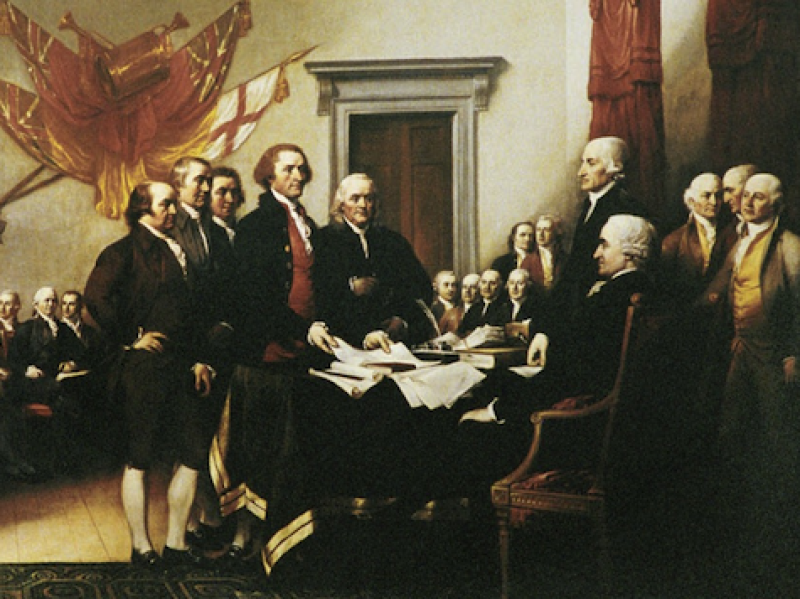'The Words That Made Us' Review: Constitutionally Speaking
By: Mark G. Spencer (WSJ)



Revolutionary America is remembered first as a theater of war. But it was also a forum for conversations about the founding of a nation.
Benjamin Franklin's "Join, or Die" cartoon.
Photo: VCG Wilson/Corbis via Getty Images By Mark G. Spencer June 23, 2021 6:26 pm ET
After 40 long days and nights of being tossed on the rough seas, on Dec. 27, 1760, the merchant vessel Racehorse finally landed in Boston. Along with its trans-Atlantic cargo came news from Britain: George II was dead. His 22-year-old grandson would be crowned George III. The transition did not bode well for the American colonies.
This anecdote and its layered consequences launch Akhil Reed Amar's fascinating book "The Words That Made Us." A masterly synthesis of history and law, Mr. Amar's tome delivers, as the author describes it, a wide-angled, multigenerational narrative of "the American constitutional project."
Revolutionary America is remembered for its physical action: "bullets flew, tea chests splashed, cannons roared." Yet, Mr. Amar argues, that's only half the story. "A cannon can roar but it cannot speak." Listening in on the Founding Fathers, Mr. Amar traces "America's constitutional conversation" from 1760 to 1840. "In each generation," he writes, "history's kaleidoscope continued to turn and create new patterns of constitutional discourse." As some issues "tumbled into view, others fell out of sight, and still others reemerged in vivid new configurations" as Americans of all stripes "participated in a boisterous and sophisticated conversation about legal and political first principles."
One early conversation involved Paxton's Case (1761), a little-known search-and-seizure lawsuit. The crown's so-called writs of assistance, the colonists felt, left merchants vulnerable to arbitrary searches. The colonists sued, and the court ruled for the crown—but not before the colonists' lawyer made a forceful case for protecting essential rights and freedoms. In an otherwise mundane argument about smuggled goods, Mr. Amar tells us, we begin to see "the profound passions, the deep tensions, and the underlying forces that would eventually rip the British Empire apart in 1776."
Pictures spoke too. Mr. Amar studies Benjamin Franklin's "Join or Die" cartoon—published in the 1750s, early in the French and Indian War, and showing a severed snake symbolizing the still disunited colonies—through "its early appearances, its hibernation, its revivals at key moments, and its evolution." By 1765, through words and images, Americans spoke "constitutionally to each other and were trying to talk to London." Some Britons—like Lord Camden and William Pitt—were listening. But not George III. "The king and his inner circle, trapped as they were in an Old World set of institutions and understandings, did not appreciate the democratic revolution exploding in the New World." America boasted "audacious newspapers, edgy cartoons, essays by anonymous authors, extralegal and self-selected assemblages everywhere, massive civil disobedience, and grand-scale performance art." Thomas Jefferson didn't write the Declaration of Independence, Mr. Amar contends. America did.
There were other conversations about early state constitutions—“designed for newspapers and for those who read them”—and about the Articles of Confederation (1781). The Articles facilitated the Northwest Ordinance (1787)—guaranteeing that “each baby state would join the Confederation on equal terms”—and eventually yielded the 1789 Constitution. Only George Washington’s support, Mr. Amar believes, was indispensable. “Imagine, for a moment,” he says, that something had happened to James Madison “as he made his way toward Philadelphia in early May 1787.” Would the Constitution have been different? Mr. Amar thinks not. Like the Declaration of Independence, the Constitution was the work of a larger body of people. Mr. Amar argues that the Bill of Rights (1791) similarly “bubbled up from a great constitutional conversation.”
Among these conversationalists, Mr. Amar lavishes praise on “media-savvy” Washington. Also ranking high in the author’s estimation are Alexander Hamilton (“America’s greatest immigrant”) and Chief Justice John Marshall (“the last founder”). Mr. Amar considers Andrew Jackson to be among the country’s “greatest early presidents.” Jackson “proved that the Constitution was indeed robust enough to work not merely for the founding generation but for posterity.” Sadly, the Constitution’s Achilles’ heel remained: Slavery’s contradiction with freedom would only deepen under Jackson. Mr. Amar’s final chapter traces the Founders’ last deeds and deathbed scenes.
Unsurprisingly, some conversations—even important ones—are overlooked or underdeveloped. Critics may feel that Mr. Amar, a professor of law and political science at Yale University, plays down Native American and African-American voices. Others may believe he neglects the contributions of women. Others still may resist his dismissal of the Madison essay known as Federalist No. 10. “For anyone purporting to explicate America’s Constitution as understood by actual Americans when enacted in 1787-1788,” Mr. Amar claims, “it simply will not do to dwell on No. 10.” That claim ignores a pivotal ratification debate. Antifederalists argued vehemently against the proposed constitution because it would establish a republic of such size that—to control the factions within its borders—it would inevitably degenerate into despotism. Drawing on Montesquieu, they declared that trajectory as an “established axiom” in the “science of politics,” one “as irrefragable as any in Euclid.” It is this objection that Federalist No. 10 strove to silence—a persistent constitutional conversation that Mr. Amar leaves untapped.
Still, readers of “The Words That Made Us” will rightly marvel at its breadth and depth and at Mr. Amar’s scholarly acumen. Sequel volumes—covering 1840 to 1920 and 1920 to 2000—are planned, making for a constitutional trilogy.
Mr. Spencer, a professor of history at Brock University, is the author of “David Hume and Eighteenth-Century America.”


